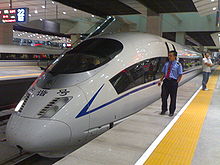Beijing – Tianjin high-speed line
| Beijing – Tianjin high-speed line | |||||||||||||||||||||||||||||||||||||||||||||||||||||||||||||||||||||
|---|---|---|---|---|---|---|---|---|---|---|---|---|---|---|---|---|---|---|---|---|---|---|---|---|---|---|---|---|---|---|---|---|---|---|---|---|---|---|---|---|---|---|---|---|---|---|---|---|---|---|---|---|---|---|---|---|---|---|---|---|---|---|---|---|---|---|---|---|---|
| Route length: | 117 km | ||||||||||||||||||||||||||||||||||||||||||||||||||||||||||||||||||||
| Gauge : | 1435 mm ( standard gauge ) | ||||||||||||||||||||||||||||||||||||||||||||||||||||||||||||||||||||
| Power system : | 25 kV / 50 Hz ~ | ||||||||||||||||||||||||||||||||||||||||||||||||||||||||||||||||||||
| Top speed: | 350 km / h | ||||||||||||||||||||||||||||||||||||||||||||||||||||||||||||||||||||
| Dual track : | continuous | ||||||||||||||||||||||||||||||||||||||||||||||||||||||||||||||||||||
|
|||||||||||||||||||||||||||||||||||||||||||||||||||||||||||||||||||||
The Beijing-Tianjin Intercity Railway is a Chinese Railway - speed rail line , operated by the State Railway of China Railway . The line is also known as the JJ-Line (JingJin DPL) ; based on the terminus Bei jing and Tian jin .
The double-track line connects the capital Beijing ( South Railway Station ) with the port city of Tianjin over a length of 117 km . It is designed for an operating speed of 300 km / h. The alignment allows speeds of up to 350 km / h.
The line runs parallel to the route of the new Beijing – Shanghai high-speed line .
history
The design speed of the line was 350 km / h in 2006, whereby the train traffic should be handled with a maximum speed of 300 km / h. The planned planning and construction time was 27 months. The construction costs amounted to 14.3 billion yuan (2.9 billion US dollars ).
The first test drives took place in March 2008. On June 24, 2008 at around 8:55 am, a CRH3 set a new speed record for rail vehicles in China with 394.3 km / h. The test drives on the route, which covered a total of more than 100,000 km, were completed on June 30, 2008.
The handover took place according to schedule on August 1, 2008, one week before the start of the 2008 Summer Olympics in Beijing. Compared to the previous route, the travel time has been reduced from 70 to around 30 minutes. In addition, the new line freed up capacities on the existing line.
Since August 2, 2008, 47 trains have been running each day and direction. For the first time in the world, a speed of 350 km / h in regular operation with passengers is achieved as planned. The minimum travel time without a stopover on the 115 km route is around 20 minutes. Since then, five CRH3s have been operating at the scheduled top speed of up to 350 km / h and six CRH2 multiple units in passenger service. There are five train stations along the route. The current total of ten trains run every 10 to 20 minutes and each take 30 minutes for the entire route.
By mid-2009, more than 13 million passengers used the route, an average of 40,000 per day, with peaks of up to 80,000 people. 70 trains run per day and direction (as of August 2008), with a minimum headway time of five minutes, which can be reduced to three minutes if necessary.
technology
For the first time in the People's Republic of China , ETCS Level 1 will be used as a train control system on the line. The track equipment was implemented by Siemens.
A slab of slab track (Bögl system) is used on the route for around 100 km .
Web links
Individual evidence
- ↑ a b c Harald Klein, Ulrike Führmann: Tempo, Tempo, Tempo. First high-speed line in China . In: tslive , October 2007 edition, Braunschweig local edition, without ISSN, p. 18.
- ↑ a b c d e f g Beijing - Tianjin high speed line opens for business. Railway Gazette International , July 31, 2008, accessed October 4, 2010 .
- ^ Announcement of the Beijing - Tianjin high-speed line . In: Eisenbahn-Revue International . Issue 6/2006, ISSN 1421-2811 , p. 300.
- ↑ a b China: CRH3 connects Beijing and Tianjian at 350 km / h ( page no longer available , search in web archives ) Info: The link was automatically marked as defective. Please check the link according to the instructions and then remove this notice. . Eurailpress , July 25, 2008
- ↑ China: New speed record ( page no longer available , search in web archives ) Info: The link was automatically marked as defective. Please check the link according to the instructions and then remove this notice. . Eurailpress , June 27, 2008
- ↑ Time-lapse from Beijing to Tianjin Handelsblatt , August 1, 2008.
- ↑ Manufacturer publication Mobility live , November 2008 edition, page 7
- ↑ Siemens Mobility: High-speed train starts operating in China . Press release from August 6, 2008
- ↑ David Bringshaw: China builds world's largest HS network . In: International Railway Journal , Volume 49, Issue 8, August 2009, pp. 20-22
- ↑ Also Germany with ETCS Level 2 . In: Eisenbahn-Revue International . No. 2 , 2016, ISSN 1421-2811 , p. 76-78 .

